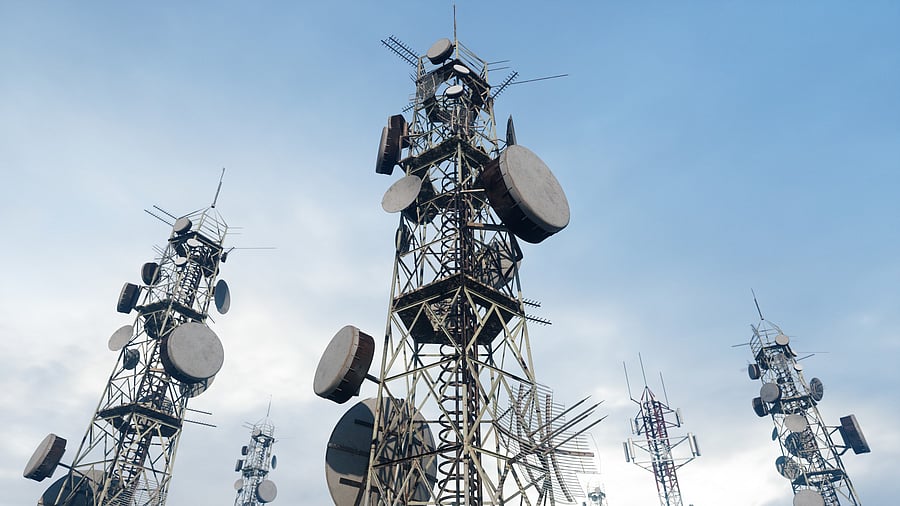
Telecom towers. Image for representation.
Credit: iStock Photo
In 2018, the central government came out with the National Digital Communications Policy that replaced the National Telecom Policy, 2012. Prime Minister Narendra Modi’s government also decided to rechristen ‘Telecom Commission’ as ‘Digital Communications Commission’.
In two key initiatives that guide the growth and development of the sector, the term ‘telecom’ was replaced with ‘digital communications’.
The National Digital Communications Policy, 2018, was focused on catering to the “modern needs of the digital communications sector of India”.
Seven years down the line, the Department of Telecommunications (DoT) has come out with a draft policy, bringing back the term ‘telecom’. The draft National Telecom Policy, 2025, is anchored in six strategic missions: universal and meaningful connectivity, fostering innovation, promoting domestic manufacturing, ensuring secure and trusted network, enhancing ease of living and doing business and advancing sustainable development
In the draft, the DoT noted that the new policy “responds to the emerging opportunities and challenges presented by next-generation technologies such as 5G/6G, Artificial Intelligence (AI), Internet of Things (IoT), Quantum Communications, Satellite Network, and Blockchain”.
“These innovations are reshaping global value chains, and India is uniquely positioned to leverage them to bridge the digital divide, foster inclusive growth, and establish itself as a global digital powerhouse,” it said.
The policy, released for public consultation, puts investments, accessibility and jobs in focus. It targets to create 10 lakh new jobs and to upskill or reskill an equal number of workers to meet the future demand. The employment generation target proposed under the draft policy is just one-fourth of the 40 lakh jobs targeted under the National Digital Communications Policy of 2018.
The 2018 policy envisaged attracting investment worth $100 billion in the telecommunications sector by 2022. The draft policy talks about Rs 1 lakh crore (nearly $12 billion) annual investment until 2030. The average annual capital expenditure (capex) in the Indian telecom sector has been close to Rs 1 lakh crore in recent years. However, a large part of this money has gone to spectrum purchases.
While the 2018 policy had set a target to provide universal broadband connectivity at 50Mbps to every citizen, the new policy talks about “universal and meaningful” connectivity. It aims to ensure that 90% of the population in the country gets access to the fifth generation (5G) telecom service, while 4G coverage is targeted to be increased to 100%.
“By aiming for 100% 4G and 90% 5G coverage by 2030, expanding fibre-connected towers, public Wi-Fi hotspots, and leveraging satellite internet for remote areas, the policy ensures universal and meaningful connectivity, even in Tier 2 and Tier 3 cities,” said Atul Vivek, Chief Business Officer, NxtCell India.
“At its core, the draft NTP aims to strengthen India’s telecom infrastructure to meet future demands, enabling high-speed, reliable, and secure connectivity across urban, rural and remote regions,” said Tony Verghese, Partner at the JSA Advocates & Solicitors.
Amid growing protectionism and global trade tensions, local manufacturing would be the key focus of the sector going forward. The policy talks about self-reliant manufacturing and exports of telecom equipment from India.
It seeks to increase domestic telecom manufacturing output by 150%, with emphasis on localisation and design-led manufacturing. The new policy also talks about achieving 50% import substitution through telecom products designed, developed, and manufactured in India.
“The focus on fiberisation, renewable-powered telecom sites, and robust rural broadband will unlock new opportunities for inclusive growth,” said Y S Surya Murthy, COO (Telecom Operations), Bondada Engineering Limited.
Amid the hype over billionaire Elon Musk-owned Starlink’s entry into the Indian markets, the new policy has proposed the establishment of a flexible and supportive regulatory framework for satellite internet services to enhance connectivity for unserved or underserved areas.